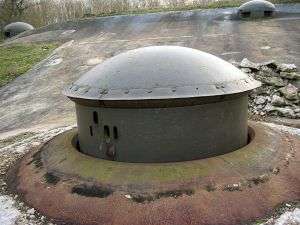Ouvrage Bois-Karre
Ouvrage Bois- Karre is located in the Fortified Sector of Thionville of the Maginot Line, facing the France - Luxembourg border. The petit ouvrage is situated in the Cattenom Forest between the gros ouvrages Soetrich and Kobenbusch, just south of Boust. It is unusual for a Maginot fortification in its construction as a single blockhouse, with no underground gallery system or remotely located entries. Bois-Karre has been preserved and is maintained as a museum.
| Ouvrage Bois-Karre | |
|---|---|
| Part of Maginot Line | |
| Northeast France | |
 Machine gun turret — note two GFM cloches to the rear | |
 Ouvrage Bois-Karre | |
| Coordinates | 49.429822°N 6.204173°E |
| Site information | |
| Controlled by | France |
| Open to the public | Yes |
| Condition | Preserved |
| Site history | |
| Built by | CORF |
| Materials | Concrete, steel, deep excavation |
| Battles/wars | Battle of France, Lorraine Campaign |
| Ouvrage Bois-Karre | |
|---|---|
| Type of work: | Small infantry work (Petit ouvrage - infantry) |
| sector └─sub-sector | Fortified Sector of Thionville └─Hettange-Grande |
| Work number: | A12 |
| Constructed: | 1930–1935 |
| Regiment: | 168th Fortress Infantry Regiment (RIF) |
| Number of blocks: | 1 |
| Strength: | 2 officers, 91 men |
Design and construction
Bois-Karre was surveyed by CORF (Commission d'Organisation des Régions Fortifiées), the Maginot Line's design and construction agency, in 1930. Work by the contractor Degaine-Dubois began in 1931,[1] and the position became operational in 1935,[2] at a cost of 10 million francs.[3][4]
Bois-Karre was planned as an anchor point for a fortified line of retreat from the Cattenom salient formed by Kobenbusch and Oberheid. A firing chamber is arranged to cover the reinforcing line (bretelle de Cattenom), which was to be anchored at its other end by Block 2 of Ouvrage Galgenberg. The reinforcing line was never built.[5]
Description
The single two-level combat block comprises two firing chambers and one machine gun turret. The west firing chamber was armed with a machine gun embrasure and a machine gun/47mm anti-tank gun embrasure (JM/AC47). The east firing chamber was equipped with two JM/AC47 embrasures and a JM embrasure. Three automatic rifle cloches (GFM) on the surface provided spotting for ouvrage Métrich, along with a machine gun turret.[1][6] The integral usine was equipped with two 40 horsepower (30 kW) Renault engines.
Several casemates, observatories and infantry shelters are located around Bois-Karre, including
- Casemate de Basse-Parthe Ouest: Single classmate flanking to the west with one JM/AC37 embrasure, one JM embrasure and one GFM cloche.
- Casemate de Basse-Parthe Est: Single classmate flanking to the east with one JM/AC37 embrasure, one JM embrasure and one GFM cloche.
- Abri du Bois-Karre: Surface shelter for one infantry section, with two GFM cloches.
- Abri du Rippert: Sub-surface shelter for two infantry sections and the quarter command post, two GFM cloches.
- Abri du Bois-de-Cattenom: Surface shelter for one infantry section, two GFM cloches.
None of these are connected to the ouvrage or to each other. All were built by CORF.[1] The Casernement de Cattenom provided peacetime above-ground barracks and support services to Bois-Karre and other ouvrages in the area.[7]
Manning
The garrison comprised 91 men and two officers of the 168th Fortress Infantry Regiment under Sub-Lieutenant Boulay.[1]
History
- See Fortified Sector of Thionville for a broader discussion of the events of 1940 in the Thionville sector of the Maginot Line.
Current condition
The ouvrage which retains a large portion of its equipment, has been restored and may be visited.[5][8]
See also
Notes
References
- Mary, Tome 3, p. 93
- Kaufmann 2006, p. 25
- Wahl, J.B. "Infanteriewerk (P.O.) Bois Karre - A12" (in German). darkplaces.org. Retrieved 12 March 2010.
- Mary, Tome 1, p. 52
- "Petit ouvrage du Bois Karre" (in French). Association Ligne Maginot du Secteur Fortifié du Bois de Cattenom. 2009. Archived from the original on 29 September 2010. Retrieved 12 March 2010.
- Puelinckx, Jean; Aublet, Jean-Louis; Mainguin, Sylvie (2010). "Bois-Karre (po A12 de)". Index de la Ligne Maginot (in French). fortiff.be. Retrieved 12 March 2010.
- Wahl, J.B. "Festungsabschnitt Thionville" (in German). darkplaces.org. Retrieved 3 May 2010.
- Kaufmann 2011, p. 221
Bibliography
- Allcorn, William. The Maginot Line 1928–45. Oxford: Osprey Publishing, 2003. ISBN 1-84176-646-1
- Degon, André; Zylberyng, Didier, La Ligne Maginot: Guide des Forts à Visiter, Editions Ouest-France, 2014. ISBN 978-2-7373-6080-0 (in French)
- Kaufmann, J.E. and Kaufmann, H.W. Fortress France: The Maginot Line and French Defenses in World War II, Stackpole Books, 2006. ISBN 0-275-98345-5
- Kaufmann, J.E., Kaufmann, H.W., Jancovič-Potočnik, A. and Lang, P. The Maginot Line: History and Guide, Pen and Sword, 2011. ISBN 978-1-84884-068-3
- Mary, Jean-Yves; Hohnadel, Alain; Sicard, Jacques. Hommes et Ouvrages de la Ligne Maginot, Tome 1. Paris, Histoire & Collections, 2001. ISBN 2-908182-88-2 (in French)
- Mary, Jean-Yves; Hohnadel, Alain; Sicard, Jacques. Hommes et Ouvrages de la Ligne Maginot, Tome 2. Paris, Histoire & Collections, 2003. ISBN 2-908182-97-1 (in French)
- Mary, Jean-Yves; Hohnadel, Alain; Sicard, Jacques. Hommes et Ouvrages de la Ligne Maginot, Tome 3. Paris, Histoire & Collections, 2003. ISBN 2-913903-88-6 (in French)
- Mary, Jean-Yves; Hohnadel, Alain; Sicard, Jacques. Hommes et Ouvrages de la Ligne Maginot, Tome 5. Paris, Histoire & Collections, 2009. ISBN 978-2-35250-127-5 (in French)
External links
- Ouvrage Bois-Karre official site
- Bois Karre at fortiff.be (in French)
- L'ouvrage du Bois-Karre at alsacemaginot.com (in French)
- ouvrage du Bois Karre at lignemaginot.com (in French)
- Petit Ouvrage du Bois Karre at mablehome.com (in French)
- Ouvrage d'infanterie du Bois Karre at wikimaginot.eu (in French)
| Wikimedia Commons has media related to Ouvrage du Bois-Karre. |